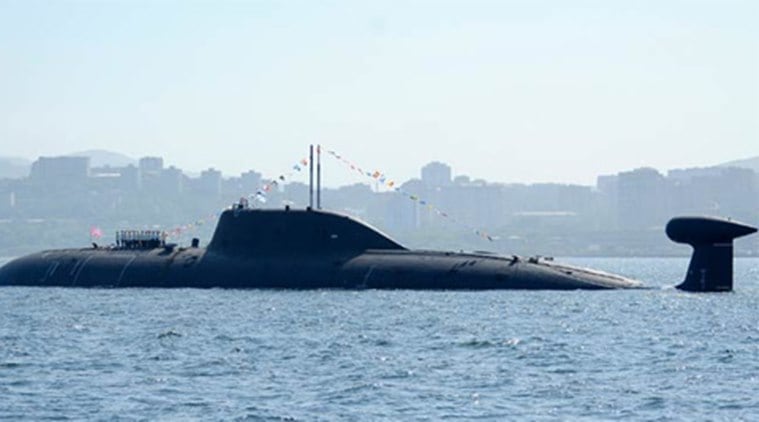INS Arihant is now operational: All about India’s nuclear deterrent in the sea
INS Arihant is a vital cog in India's quest in attaining a minimum deterrent nuclear 'triad', which is the ability to fire nuclear-tipped missiles from land, air and sea.
By: Express Web Desk | New Delhi | Updated: November 6, 2018 6:53:33 am
 INS Arihant is the first indigenously developed nuclear submarine with Indian Navy. (Source: Reuters)
INS Arihant is the first indigenously developed nuclear submarine with Indian Navy. (Source: Reuters)INS Arihant, India’s first indigenously developed nuclear submarine, returned to the Indian shores on Monday after successfully completing its first deterrence patrol. The submarine is a vital cog in India’s quest in attaining a minimum deterrent nuclear ‘triad’ – the ability to fire nuclear-tipped missiles from land, air and sea.
Here’s all you need to know about INS Arihant.
How long did it take to develop INS Arihant?
The submarine was sanctioned using secret funds in the late 1970s by then Prime Minister Indira Gandhi after India conducted its first nuclear test. The design and technology of INS Arihant was locked in 1984 when the formal go-ahead was given. Work on the submarine started in 1998. It took the Ship Building Centre (SBC) almost 11 years to construct the country’s first indigenous nuclear-powered submarine.
INS Arihant was launched on July 26, 2009 by the then Prime Minister Manmohan Singh to mark 10 years since the end of the Kargil War. In August 2013, the submarine’s atomic reactor was activated. In August 2016, Prime Minister Modi inducted the submarine into the Navy.
What is the composition of INS Arihant?
INS Arihant is a 6,000-tonne submarine with a length of 110 metres and a breadth of 11 metres. The vessel will be able to carry 12 Sagarika K 15 submarine launched ballistic missiles that have a range of over 700 km.
How INS Arihant is different from other submarines?
India has been vying to equip its naval forces with nuclear arsenal ever since it successfully conducted Pokhran-II nuclear tests in 1998. Strategic Strike Nuclear Submarines (SSBNs) are a way forward in this direction. They are different from conventional SSK submarines, which use a diesel-electric engine as their power source, and have to surface daily to get oxygen for fuel combustion.
READ | Going nuclear at sea
SSBNs are bigger in size and are powered by a nuclear reactor and as a result, they can function submerged for months without having to surface. This feature allows them to travel further and with greater stealth. SSBNs are supposed to be the best guarantor of a second-strike capability in a nuclear exchange. India has said it is committed to not using nuclear weapons first.
SSBNs like the INS Arihant are also different from the nuclear-powered attack submarines (SSN), as they can carry ballistic missiles with nuclear warheads.
What missiles does the INS Arihant have for a nuclear strike?
INS Arihant is fitted with 12 Sagarika K-15 submarine-launched ballistic missiles (SLBMs). The missile, however, has a strike radius of about 750 to 800 km, which pales in comparison with what Chinese nuclear submarines carry. The DRDO is working on two longer-range SLBMs: the 3,500-km range K-4 and the 5,000-km range K-5.
So what submarines does the Indian Navy now have?
The Navy currently has 14 SSKs — nine Sindhughosh-class (Russian Kilo class), four Shishumar-class (German Type 209) and one Kalvari-class (Scorpene class) submarines. Besides these, the navy also has one SSN, INS Chakra, a Russian Akula-class submarine taken on lease in 2012 for 12 years.
INS Arihant will be the first SSBN-type submarine in the Navy. It has also been reported that it’s sister vessel, the INS Aridhaman, is nearing completion.
Interestingly, the size of the Arihant is similar to the first nuclear submarine in the world that was launched four decades ago by the US. Besides the US, which has 74 nuclear submarines, Russia (44), UK (13), France (10) and China (10) also possess nuclear-powered submarines. The last nation to enter the nuclear submarine club was China when it launched its Han class submarines in the early 1980s.
China has started mass producing its second generation of nuclear submarines. India has a lot of catching up to do as the new “Shang” and “Jin” class submarines —are a big leap ahead of their older and noisier Han class submarines.





































No hay comentarios:
Publicar un comentario